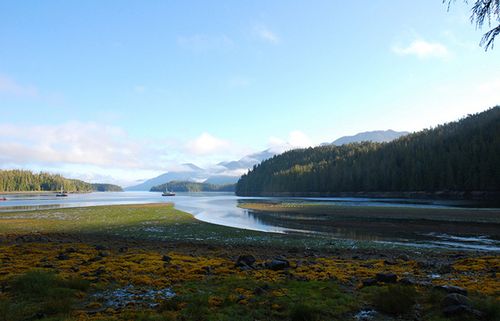
If the U.S. doesn't allow the northern half of the Keystone XL pipeline to be built, Canada is just going to sell its oil to power-hungry China. That's one of the common rebuttals to opposition of the proposed Keystone XL pipeline that would allow oil derived from oil sands (known colloquially╠řas tar sands) from northern Alberta to flow to refineries along the U.S. Gulf╠řCoast.╠ř
Whether or not the full Keystone XL gets built, Canadian pipeline builder Enbridge wants to connect Edmonton with the port of Kitimat in northern British Columbia, where oil would be loaded onto tankers and shipped through the Douglas Channel,╠ř and . Called the Northern Gateway Project, the pipeline would run 730 miles, traversing the Rockies and Coast mountain ranges before its terminus in British ColumbiaÔÇÖs Great Bear Rainforest, one of the largest contiguous tracts of temperate rainforest left in the world.
, a team of conservationists and scientists, opposes the project due to what it considers grave threats placed on the B.C. coast and its aboriginal people should an oil spill occur. Chris Darimont, the group's director of science and a B.C. coast surfer,╠řattracted Patagonia's attention to the pipeline plans. Subsequently, Patagonia ambassadors and surfing filmmakers the Malloy brothers╠řbecame involved. The result is Groundswell, a short film the brothers shot last year during a sailing and surfing expedition to the Great Bear Rainforest. The film, due out in October, will serve to advocate against the pipeline and for the rainforests and its inhabitants. (Click here for a Q&A with Chris Malloy and the trailer for Groundswell.)
Enbridge is ready to sink $5.5 billion into the project and says it will employ state-of-the-art safety equipment and protocols, bring 1,150 long-term jobs, and “drive gross domestic product growth across Canada by $270 billion during the first 30 years of operation.” ╠ř
But First Nation tribes that live along the northern B.C. coast have banded together to oppose the pipeline, through the . They say the government's safety assessments of the project are flawed and that First Nation people would be disproportionately harmed by a tanker spill along the coast.
However, opposition to the pipeline isn't universal among Canada's Aboriginal people, to whom Enbridge is offering a 10 percent share in the project, which it estimates would amount to $280 million over 30 years. Some inland tribes have signed on to the deal.
Aside from coastal communities, the marine life, avian populations, and fauna along the coast is obviously vulnerable to a spill. The Great Bear Rainforest is home to╠ř2,500 salmon runs, according to the Raincoast Conservation Foundation, and these fish are a fundamental food source for grizzlies, wolves, and black bears in the area, including , a genetically unique sub-species of black bear. There are believed to be fewer than 400 Spirit Bears, all of them on the B.C. coast.
Darimont and the Raincoast Conservation Foundation are concerned not only over the vulnerability of the Great Bear Rainforest but also over escalating the use of fossil fuels and the impact this is having globally.╠ř
Raincoast will be presenting the foundation's opposition to the pipeline during a government hearing this fall.╠řThe decision is ultimately in the hands of a three-person Joint Review Panel, assembled by╠řCanada's Environmental Assessment Agency and National Energy Board. Darimont says a final decision will likely be made by the end of this year or early 2013.
“I'm an advocate of informed advocacy,” says Darimont, who is also a post-doctoral fellow in environmental studies at the University of California, Santa Cruz. “We work with the best available science and many of us are scientists and professors.╠řThis [pipeline] is the singular issue not just for our coast but also for North America. Not just because of climate change, but because of First Nation sovereignty.”
–Mary Catherine O'Connor
╠ř
╠ř